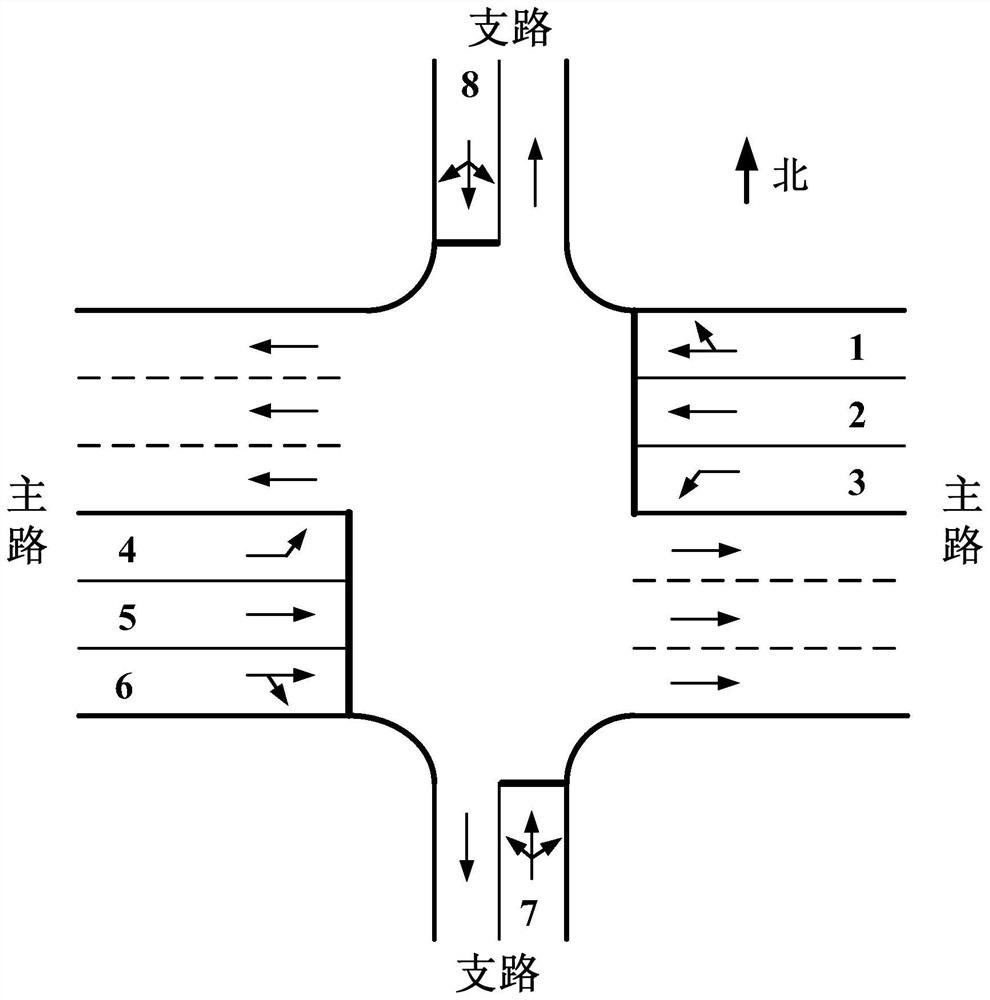A Traffic Signal Timing Method at the Intersection of Main and Branch Roads
A traffic signal and signal timing technology, which is applied in the direction of traffic signal control, can solve the problems of low traffic efficiency, short cycle time, and inapplicability, so as to improve efficiency and alleviate traffic congestion
- Summary
- Abstract
- Description
- Claims
- Application Information
AI Technical Summary
Problems solved by technology
Method used
Image
Examples
specific Embodiment approach 1
[0019] Specific implementation mode one: the concrete process of the traffic signal timing method of a kind of main branch road intersection of this embodiment is:
[0020] Step 1: Obtain the arrival motor vehicle flow of each phase of the intersection;
[0021] Step 2: Transform the arriving motor vehicle flow at each phase of the intersection;
[0022] Step 3: Convert the number of lanes controlled by each phase at the intersection;
[0023] Step 4: Calculate the weight coefficients of each phase of the intersection based on Step 2 and Step 3;
[0024] Step 5: Determine the green light interval time of each phase of the intersection;
[0025] Step 6: Calculate the intersection signal timing parameters; the specific process is:
[0026] Step 61: Calculate the initial cycle duration C of the intersection 0 , the unit is s;
[0027] Step 62: Calculate the green time g of the intersection phase n n , the unit is s;
[0028] Step 63: Calculate the optimal cycle duration C ...
specific Embodiment approach 2
[0030] Specific embodiment two: the difference between this embodiment and specific embodiment one is that the arrival motor vehicle flow of each phase of the intersection is obtained in the step one; the specific process is:
[0031] Investigation and analysis period (such as evening peak 17:00-18:00 or flat peak) the motor vehicle flow of each lane; , Branch roads are regulated, generally the default main road is a road with more lanes and higher road grade, and the branch road is a road with fewer lanes and lower road grade.) There are N phases in total at the intersection, where The number of lanes controlled by phase n is x n , the sum q of the arrival motor vehicle flow of each lane controlled by phase n in the analysis period n ,q n The calculation method is shown in formula (1):
[0032]
[0033] In the formula: is the arrival motor vehicle flow of the kth lane controlled by phase n, the unit is pcu / h; 1≤n≤N.
[0034] Other steps and parameters are the same as...
specific Embodiment approach 3
[0035] Specific embodiment three: the difference between this embodiment and specific embodiment one or two is that in the step two, the arrival motor vehicle flow of each phase of the intersection is converted; the specific process is:
[0036] use Q n Indicates that q n The converted value, Q n The calculation method is shown in formula (2):
[0037]
[0038] In the formula: q max It is the maximum value of motor vehicle flow in each phase, unit: pcu / h; q min It is the minimum value of motor vehicle flow rate arriving at each phase, the unit is pcu / h; 1≤n≤N;
[0039] q max =max(q 1 ,q 2 ,...,q n ,...,q N ) (3)
[0040] q min =min(q 1 ,q 2 ,...,q n ,...,q N ) (4).
[0041] Other steps and parameters are the same as those in Embodiment 1 or Embodiment 2.
PUM
 Login to View More
Login to View More Abstract
Description
Claims
Application Information
 Login to View More
Login to View More - R&D
- Intellectual Property
- Life Sciences
- Materials
- Tech Scout
- Unparalleled Data Quality
- Higher Quality Content
- 60% Fewer Hallucinations
Browse by: Latest US Patents, China's latest patents, Technical Efficacy Thesaurus, Application Domain, Technology Topic, Popular Technical Reports.
© 2025 PatSnap. All rights reserved.Legal|Privacy policy|Modern Slavery Act Transparency Statement|Sitemap|About US| Contact US: help@patsnap.com



